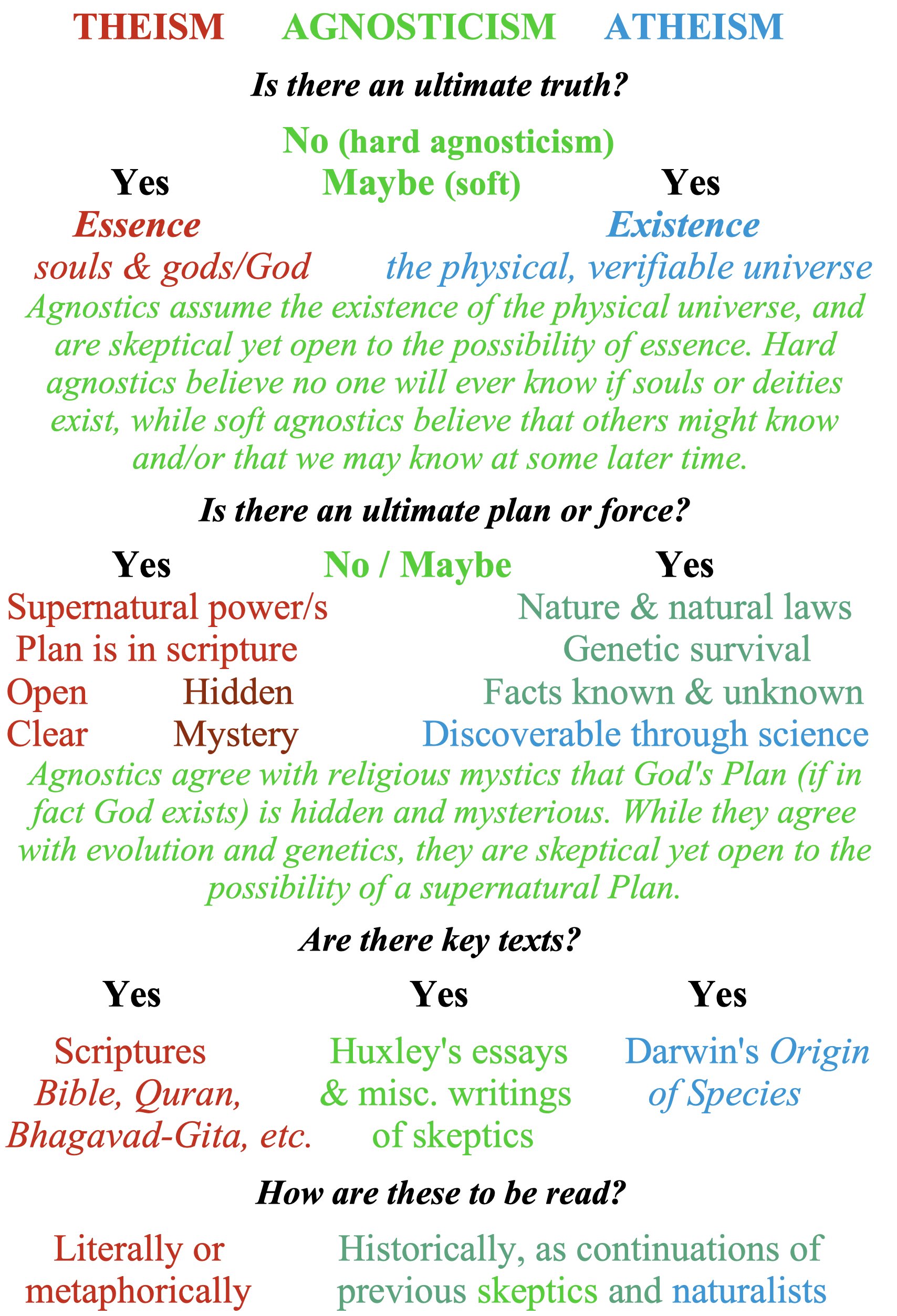The Double Refuge 🍏 Starting Points
Core Beliefs
A Gluten-free Eucharist - 5 Points - Open Agnosticism - Q & A
🍏
A Gluten-free Eucharist
The core beliefs of religion are well known. For me, this is part of the problem: they are too well known, too specific, too insisted upon. How can one say that one religion is the absolute Truth when religions insist on different versions of reality, and when even the sects within a single religion define their differences with razor-sharp precision? Part of my aim in The Double Refuge is to dull these differences, to let go of these fine distinctions.
I imagine a world in which one believer chats with the next without worrying about whether God is a Trinity in One, or One in the Trinity. Beyond this ecumenical dream is the global dream, where we no longer have to insist that it’s either Christ or Krishna who has come to save us. Or that it’s either the Trimurti (Brahma, Vishnu, and Shiva) or the Trinity (the Father, the Son, and the Holy Ghost) that reigns in the starry heavens above us. Perhaps it’s time to jettison this either / or and think in terms of either / and.
I mean, is it really important whether we see the eucharist wafer as the body of Christ or as a symbol of His body? Years ago I was wandering down Spaccanapoli when I saw a very old church with a small sign on its door. The sign informed the general public that they offered gluten-free wafers for communion. Then, several years later, to correct this grave error in doctrine, the Vatican ruled that Christ can only be transubstantiated in wheat wafers, not in gluten-free wafers. Here we have it in the Vatican’s 2017 “Letter to Bishops on the bread and wine for the Eucharist:”
Hosts that are completely gluten-free are invalid matter for the celebration of the Eucharist. Low-gluten hosts (partially gluten-free) are valid matter, provided they contain a sufficient amount of gluten to obtain the confection of bread without the addition of foreign materials and without the use of procedures that would alter the nature of bread (A. 1-2).
I am Celiac. 1.6% of Italy is Celiac. “A sufficient amount of gluten” is exactly what almost killed me back in 2010. I was down to 110 pounds. 50 kilos. It now sounds like a fancifully, desirably slim number, but I could count every rib. I saw my uncle die slowly, becoming thinner and thinner every year till his system shut down completely. This was before they realized how insidious Celiac Disease is: the cause — gluten — isn’t obviously connected to the effect — a degraded digestive system in which one of the few things you can digest is wheat!
Gluten-free wafers! Angels doing the tango on the head of a pin when they ought to be waltzing! Why on earth do we create such fine distinctions?
While religion suffers from being too insistent on the fine points, agnosticism suffers from not being defined clearly enough. This is understandable, since agnostics tend to reject labels. Yet while agnostics avoid labels, doctrines, and final conclusions, they do have core beliefs. They’ll scrap these beliefs if they have a religious experience, yet for the moment they’re beliefs nonetheless. These beliefs are grounded in physical, psychological, and phenomenological reality, and thus — because there’s much about physics, our minds, and experience itself that eludes us — these grounds allow for the possibility of mystical or spiritual experiences.
🍏
5 Points
Given the overall contingency of agnostic belief, the following five “core beliefs” should be taken with five large grains of salt:
1. Everything changes and hence our understanding of everything also changes. To insist on a rigid doctrine or explanation is, in time, to invite the mockery of Time.
2. We’re basically animals with amazingly complex nervous systems. Our brains allow us to think, to become self-aware, and to create ideas about where we come from and who we are. Our brains also allow us to debate these ideas and to consider alternatives. Debate and dissent aren’t erring tangents from truth so much as they’re natural functions of our curiosity. They suggest that we’re not just machines that are predetermined by atoms and angles to think in one way.
3. Since medical science and astronomy are still exploring what and where we are, it’s too early to exclude the possibility that we’re capable of experiencing — or making contact with — dimensions or entities that are beyond present verification. This is especially true in regard to astronomy: because we’ve only explored a tiny percent of the universe, we remain ignorant about the largest parameters of material reality, of which we’re only a tiny part. We live in a world of constant change, and these changes take place within a tiny fraction of both the spatial and temporal framework of the universe. We can’t claim to know what realities exist sextillions of parsecs from Earth, and we can’t claim to know how what’s above us affects or determines what’s around and within us. Any gospel about the nature of the universe, or about the relation of the universe to life on Earth, is premature.
4. Although science hasn’t fully explained the brain, and has only started to explain the universe, it still appears to be the most reliable method of arriving at truth. Science’s domain is vast, since it includes observations and temporary conclusions, as well as speculations and hypotheses about things we don’t yet understand. In this sense, the open exploration of the scientist is very close to the open exploration of the agnostic. Here it’s very important to distinguish the scientist from the positivist. A scientist can be theistic, agnostic, or atheist, whereas positivists argue that only the scientific method can guarantee truth. Agnostics cherish the scientific method, yet, like many scientists, they aren’t convinced that science can or will explain everything.
5. Because of the gaps in our knowledge, and because of the limitations of our senses and our means of verification, agnostics believe that we should remain open to all possible sources of information and to all sorts of ideas and experiences. We should even remain open to religious ideas which contradict historical records, as well as to metaphysical ideas which contradict the laws of physics. While agnostics believe in these records and these laws, they doubt the completeness of our understanding. Just as we discovered the two libraries at Nineveh in the middle of the 19th century, and just as we discovered the Dead Sea scrolls in the middle of the 20th century, so we might find other ground-breaking sources in the years to come. While agnostics are in no way convinced about religious assertions, they’re not willing to close the door on the possibilities of religion. They often have a sense that science and religion are different methods of getting at the nature — and at the wonder — of our existence. Even if we dismiss literal readings of religion, there remains a great deal of value in its myth, symbol, imagination, speculation, and art.
Not to mention Beauty. Agnostics tend to read scripture as literature, and to see religion as art. Not surprisingly, many agnostics also see literature and art as religion — in the sense that they awaken us to the beauty that lies in specific physical forms yet also projects itself further, as if on an epic sentiment, toward the open sea.
🍏
Open Agnosticism
In The Double Refuge I focus on 🔺 the nature of agnosticism, located as it is between belief and disbelief, and on 🔺 the way the open exploration of agnosticism can overlap with theism. The graphic below illustrates my focus on the way agnosticism can flow into belief or disbelief, and the way that open belief and open doubt are especially compatible. Note that the arrows emanating from the double refuge don’t go all the way to the extremes of belief and disbelief: the arrow on the left doesn’t reach a belief that rejects other forms of belief; the arrow on the right doesn’t reach a disbelief that insists on the rejection of all forms of belief.
Nor does the solid arrow to the right reach what I will discuss later, hard agnosticism, which insists that doubt is all we have. Throughout The Double Refuge I focus instead on soft or open agnosticism, which doubts that doubt is all we have. I believe that this is a more consistent definition of agnosticism; it doesn’t allow doubt to become a fixed or certain doctrine. Open agnosticism is clearly what the originator of the term, Thomas Huxley, meant. In his notion of agnosticism, science is very much included, yet he insisted that true science is open to all possibilities, including those of a speculative metaphysical or theological nature. One of Huxley’s key statements is the following, made in 1884:
… Agnosticism puts aside not only the greater part of popular theology, but also the greater part of anti-theology. On the whole, the “bosh” of heterodoxy [anti-theology] is more offensive to me than that of orthodoxy [theology], because heterodoxy professes to be guided by reason and science, and orthodoxy does not.
I return to the importance of open agnosticism in A Middle Position, Rivers of Change, Huxley’s Definition, and The Unconvinced.
🍏
Q & A
The following chart simplifies a great deal, yet it aims to clarify the basic ways that agnosticism aligns with, or diverges from, theism & atheism.






